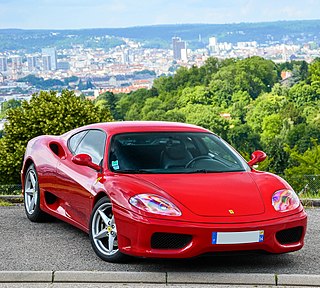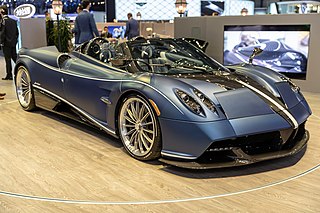
The McLaren F1 is a sports car designed and manufactured by British automobile manufacturer McLaren Cars and powered by the BMW S70/2 V12 engine. The original concept was conceived by Gordon Murray, who successfully convinced Ron Dennis to back the project and hired car designer Peter Stevens to design the exterior and interior of the car. On 31 March 1998, the XP5 prototype with a modified rev limiter set the Guinness World Record for the world's fastest production car, reaching 240.1 mph (386.4 km/h), surpassing the modified Jaguar XJ220's 217.1 mph (349 km/h) record from 1993.

The Mitsubishi Lancer Evolution, popularly referred to as the 'Evo', is a sports sedan and rally car based on the Lancer that was manufactured by Japanese manufacturer Mitsubishi Motors from 1992 until 2016. There have been ten official versions to date, and the designation of each model is most commonly a Roman numeral. All generations use two-litre intercooled turbo inline four-cylinder engines and all-wheel drive systems.

The Lotus Esprit is a sports car built by Lotus Cars from 1976 to 2004 at their Hethel, England factory. It has a rear mid-engine, rear-wheel-drive layout. Together with the Lotus Elise / Exige, it is one of Lotus' most long-lived models.
A World Rally Car is a racing automobile built to the specific regulations set by the Fédération Internationale de l'Automobile (FIA) and designed for competition in the World Rally Championship (WRC). The cars were introduced in 1997 as a replacement for Group A regulations used in the manufacturers' championship, and were replaced by Group Rally1 in 2022.

The Ferrari 360 is a two-seater, mid-engine, rear wheel drive sports car manufactured by Italian automotive manufacturer Ferrari from 1999 until 2005. It succeeded the Ferrari F355 and was replaced by the Ferrari F430 in 2004.

The Ferrari F430 is a sports car produced by the Italian automobile manufacturer Ferrari from 2004 until 2009 as a successor to the Ferrari 360. The car is an update to the 360 with exterior and performance changes. It was unveiled at the 2004 Paris Motor Show. The F430 was succeeded by the 458 which was unveiled on 28 July 2009.

The Ferrari 599 GTB Fiorano is a grand tourer produced by Italian automobile manufacturer Ferrari. It was the brand's front engined, two-seat model that replaced the 575M Maranello in 2006 as a 2007 model, and was replaced for the 2013 model year by the F12berlinetta.

The Pagani Zonda is a mid-engine sports car produced by Italian sports car manufacturer Pagani. It debuted at the 1999 Geneva Motor Show. Produced on commission in limited units, as of 2019 a total of 140 cars had been built, including development mules. Variants include a 2-door coupé and roadster variant, along with a third new variant being the barchetta. Construction is mainly of carbon fibre.

The Koenigsegg CCX is a mid-engine sports car manufactured by Swedish automotive manufacturer Koenigsegg Automotive AB. The project began with the aim of making a global car, designed and engineered to comply with global safety and environment regulations, particularly to enter the United States car market. To sell cars in the US, many alterations were made to the design of the CCR; the previously used Ford Modular engine was replaced by an in-house developed Koenigsegg engine designed to run on 91 octane fuel, readily available in the United States, and to meet Californian emission standards.
Dome Co. Ltd, literally "child's dream", is a Japanese racing car constructor involved mainly in open-wheel and sports car racing.

The Brabham BT49 is a Formula One racing car designed by South African Gordon Murray for the British Brabham team. The BT49 competed in the 1979 to 1982 Formula One World Championships and was used by Brazilian driver Nelson Piquet to win his first World Championship in 1981.

The Supermarine Aircraft Spitfire is an American homebuilt aircraft produced in kit form by Supermarine Aircraft. A replica of the famous British Supermarine Spitfire World War II fighter, it was originally produced to 75% scale. Subsequent models have increased the scale of the fuselage and added a second seat.

The Dome F105 was an unraced Formula One car designed and built by the Japanese motorsport constructor, Dome.

The Pagani Huayra is a mid-engine sports car produced by Italian sports car manufacturer Pagani, succeeding the company's previous offering, the Zonda. It is named after Wayra Tata, the Quechua wind god. The Huayra was named "The Hypercar of the Year 2012" by Top Gear magazine. On 11 February 2015 it was reported that the Pagani Huayra has been sold out. The Huayra was limited to just 100 units as part of Pagani's agreement with engine supplier Mercedes-AMG.
The Subaru 1235 was a motor racing engine designed and built by Motori Moderni, and funded by Subaru for the Japanese manufacturer’s Formula One program in 1990. A 3.5-litre boxer-12, it was used by the Coloni team for the first eight races, but proved to be very unsuccessful and the team reverted to using the old Cosworth DFR V8 engine. Alba also used it in the World Sportscar Championship in 1990, but were similarly unsuccessful and switched to a 4.5-litre Buick V6 midway through the season.

The McLaren 570S is a sports car designed and manufactured by British car manufacturer McLaren Automotive from 2015 until 2021. It was unveiled at the 2015 New York International Auto Show.

The McLaren 720S is a sports car designed and manufactured by British automobile manufacturer McLaren Automotive. It is the second all-new car in the McLaren Super Series, replacing the 650S beginning in May 2017.

The Bugatti Divo is a mid-engine track-focused sports car developed and manufactured by Bugatti Automobiles S.A.S. The car is named after French racing driver Albert Divo, who raced for Bugatti in the 1920s winning the Targa Florio race twice. It was revealed on 24 August 2018 at “The Quail – A Motorsports Gathering“ in California, United States.
The GMA is a 4.0-litre, naturally aspirated V12 engine, commissioned by Gordon Murray, and developed and produced by Cosworth for the Gordon Murray Automotive T.50 & T.33 sports cars. The road-going engine is rated at 663 PS at 11,500 rpm, with a max torque figure of 467 N⋅m (344 lbf⋅ft) at 9,000 rpm, making it the highest revving road car engine ever produced. The engine is also more powerful than the 6.1 L (6,064 cc) S70/2 V12 engine used in the McLaren F1, making more power from four litres than the S70/2 made from 6.1 litres.


















